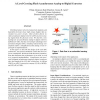Free Online Productivity Tools
i2Speak
i2Symbol
i2OCR
iTex2Img
iWeb2Print
iWeb2Shot
i2Type
iPdf2Split
iPdf2Merge
i2Bopomofo
i2Arabic
i2Style
i2Image
i2PDF
iLatex2Rtf
Sci2ools
ASYNC
2006
IEEE
2006
IEEE
A Level-Crossing Flash Asynchronous Analog-to-Digital Converter
Distributed sensor networks, human body implants, and hand-held electronics have tight energy budgets that necessitate low power circuits. Most of these devices include an analog-to-digital converter (ADC) to process analog signals from the physical world. We describe a new topology for an asynchronous analog-to-digital converter, dubbed LCF-ADC, that has several major advantages over previously-designed ADCs, including reduced energy consumption and/or a simplification of the analog circuits required for its implementation. In this paper we describe the design of the LCF-ADC architecture, and present simulation results that show low power consumption. We discuss both theoretical considerations that determine the performance of our ADC as well as a proposed implementation. Comparisons with previously designed asynchronous analog-to-digital converters show the benefits of the LCF-ADC architecture. In 180 nm CMOS, our ADC is expected to consume 43 µW at 160 kHz, and 438 µW at 5 MHz....
Analog-to-digital Converters | ASYNC 2006 | Asynchronous Analog-to-digital Converters | Hardware | Low Power |
| Added | 10 Jun 2010 |
| Updated | 10 Jun 2010 |
| Type | Conference |
| Year | 2006 |
| Where | ASYNC |
| Authors | Filipp Akopyan, Rajit Manohar, Alyssa B. Apsel |
Comments (0)

